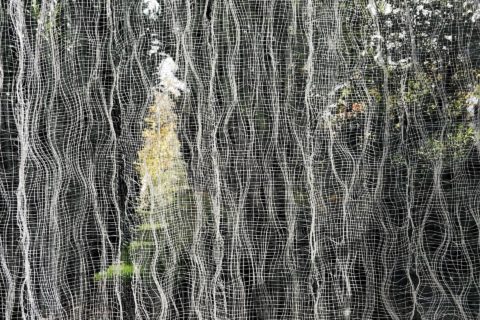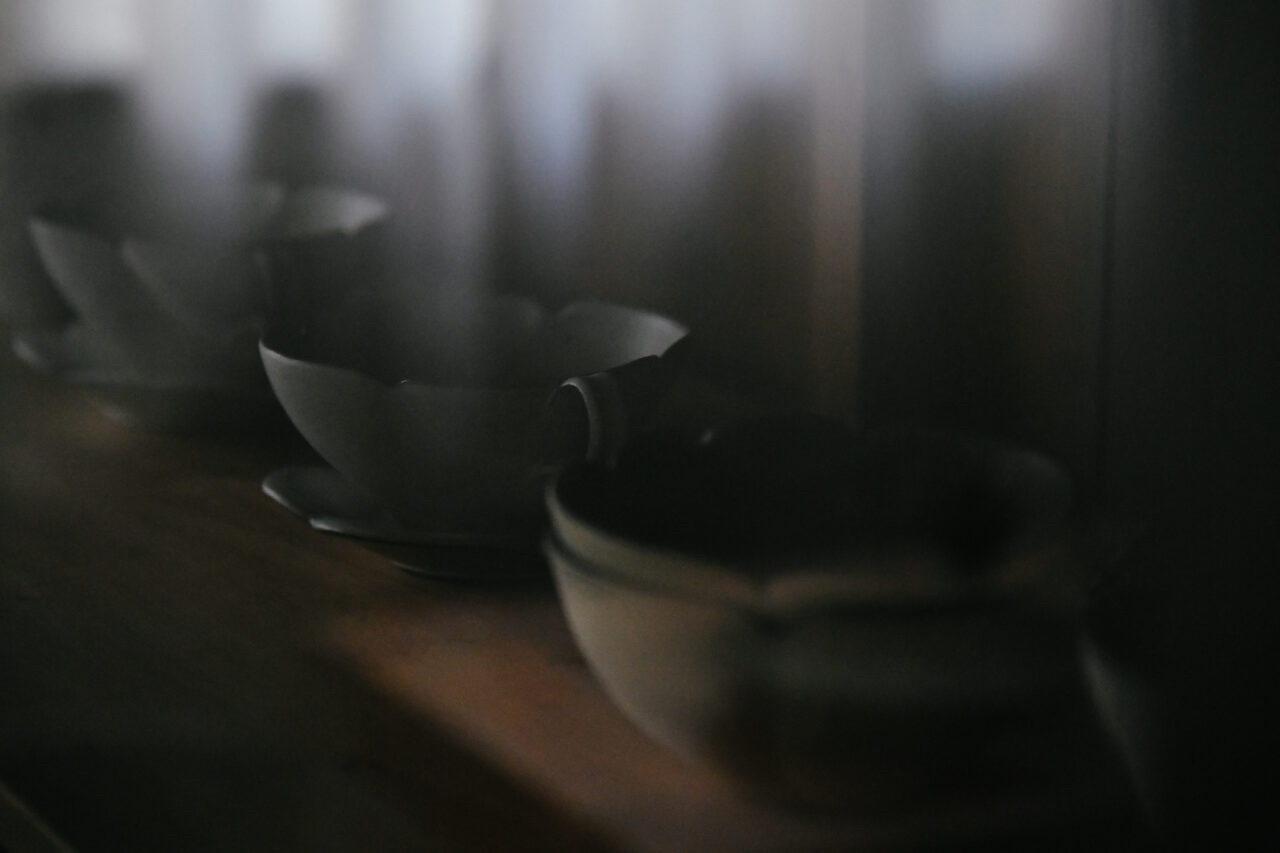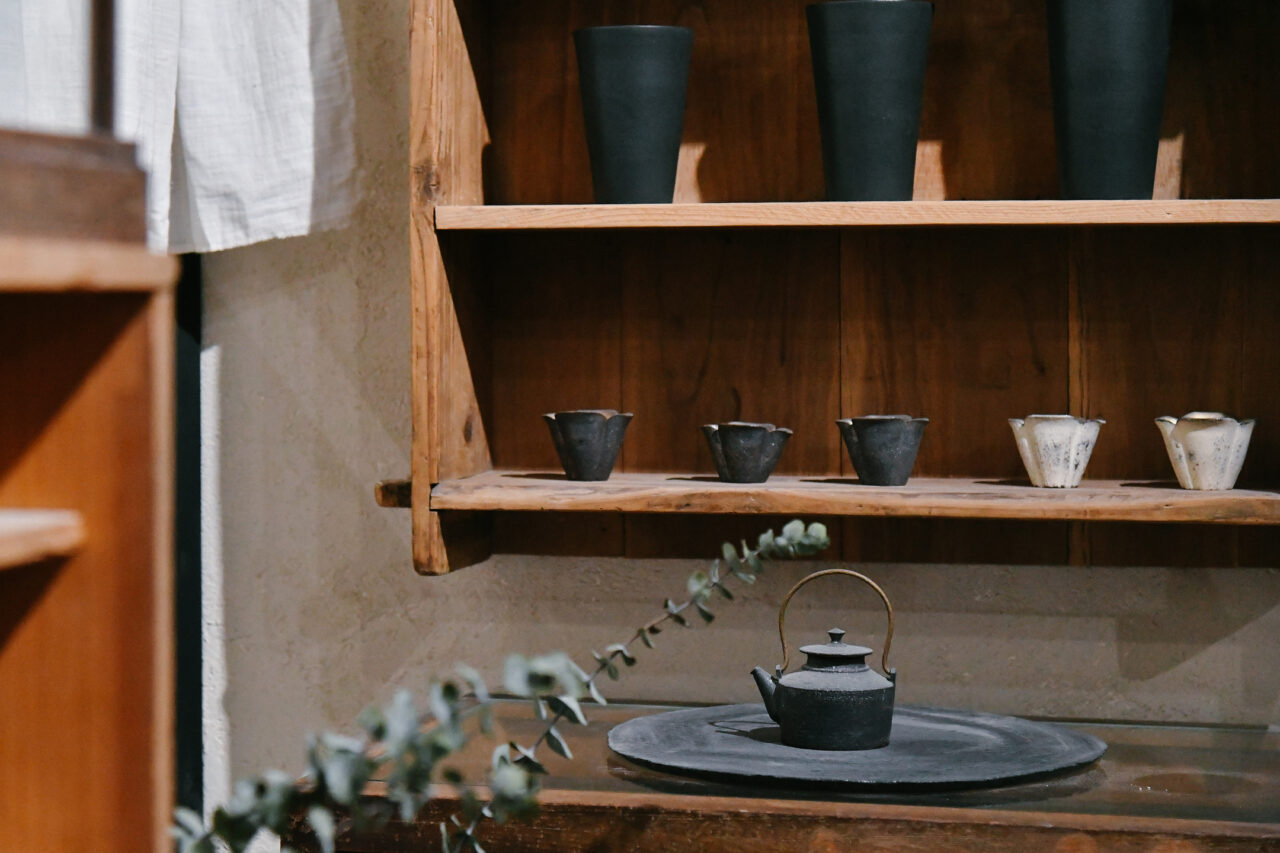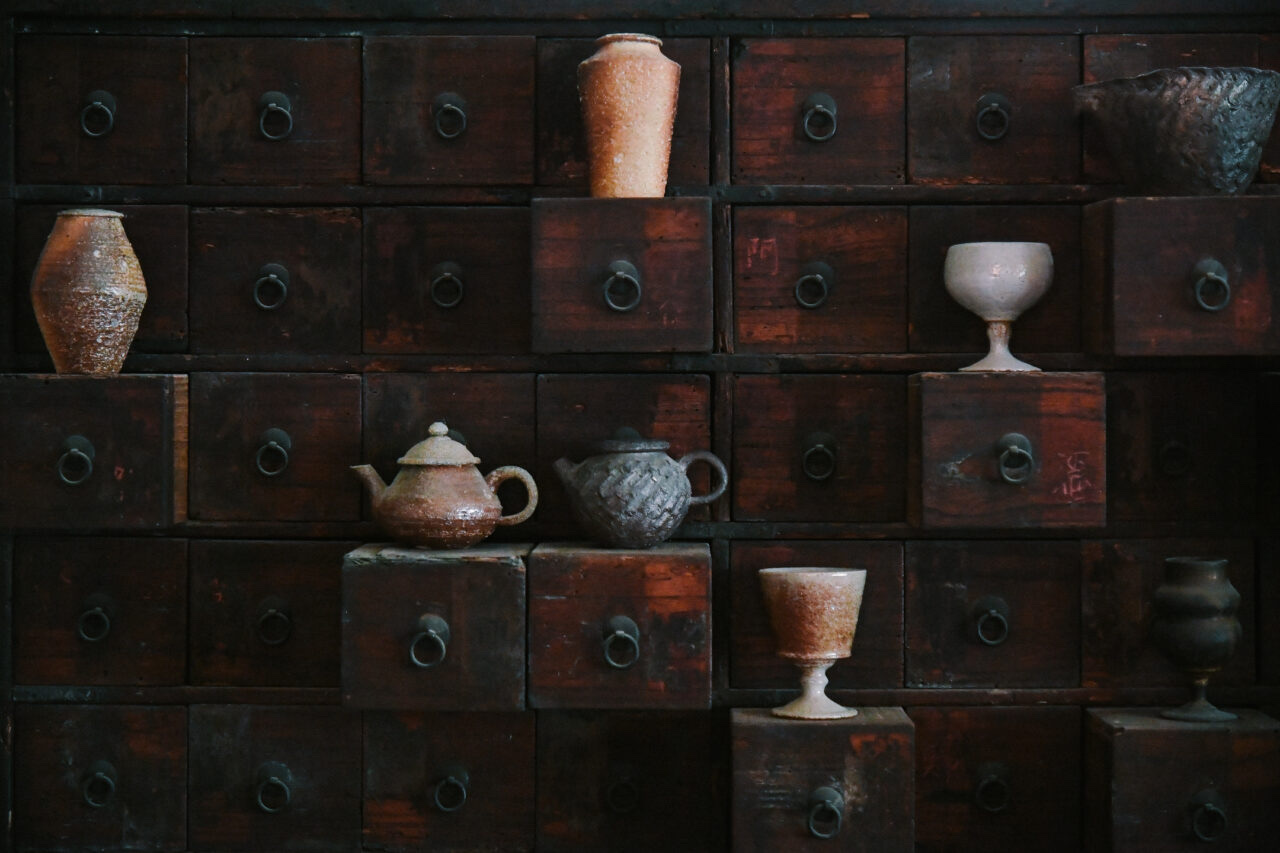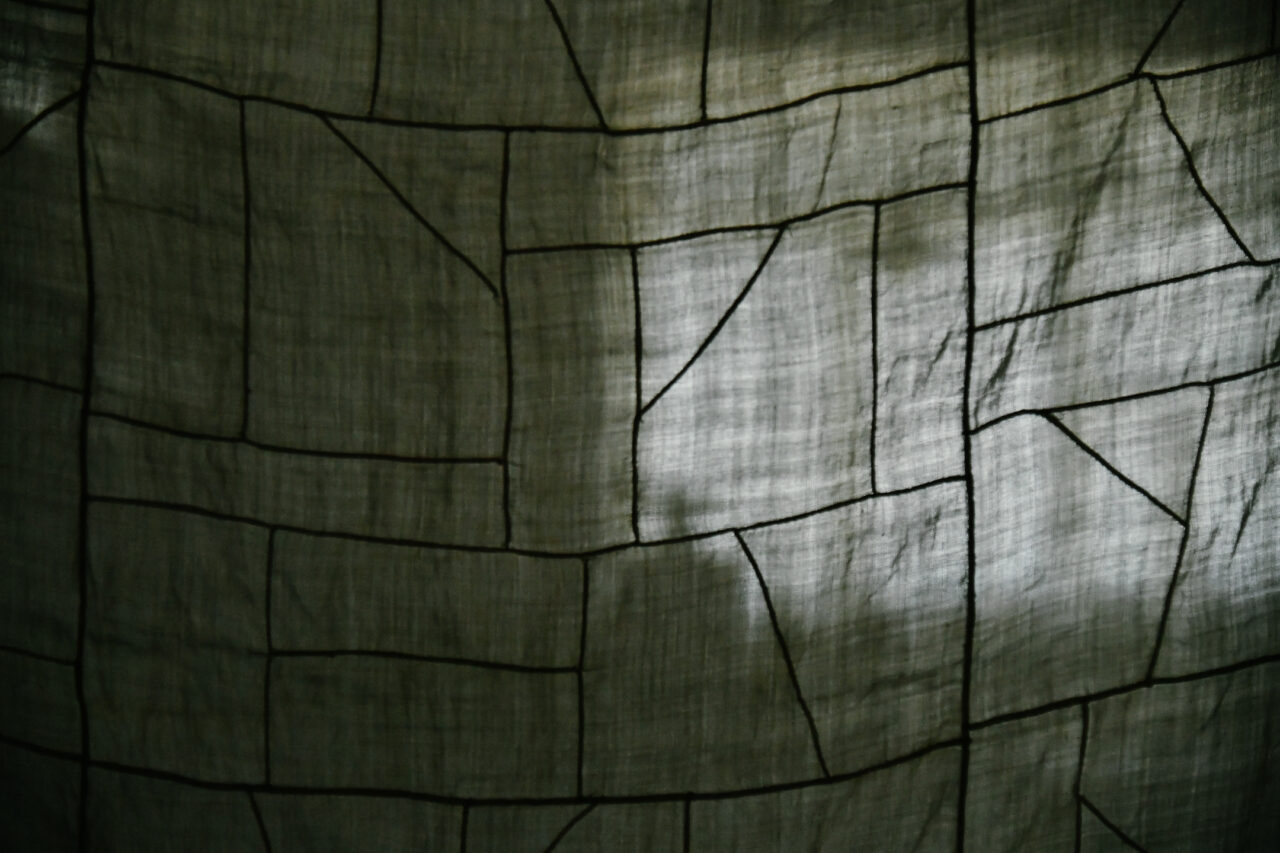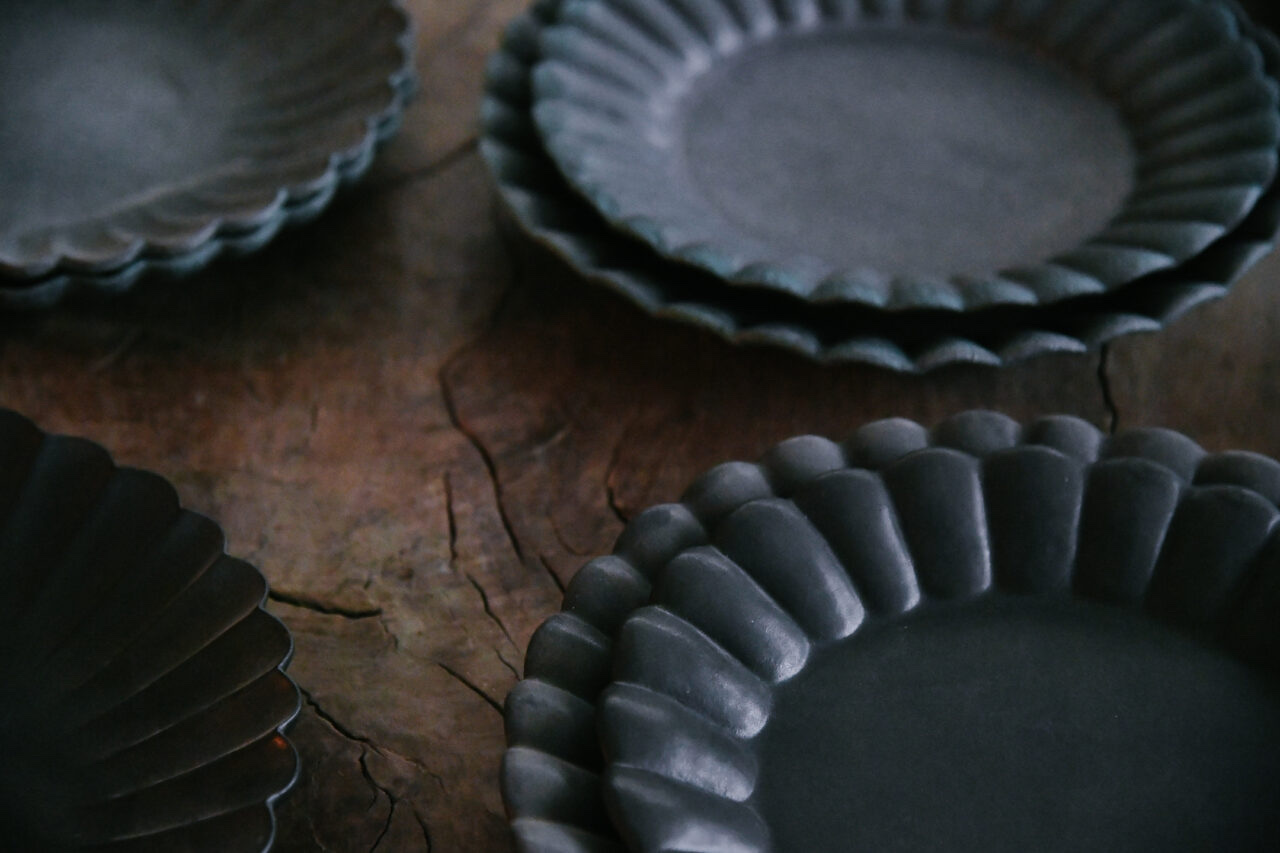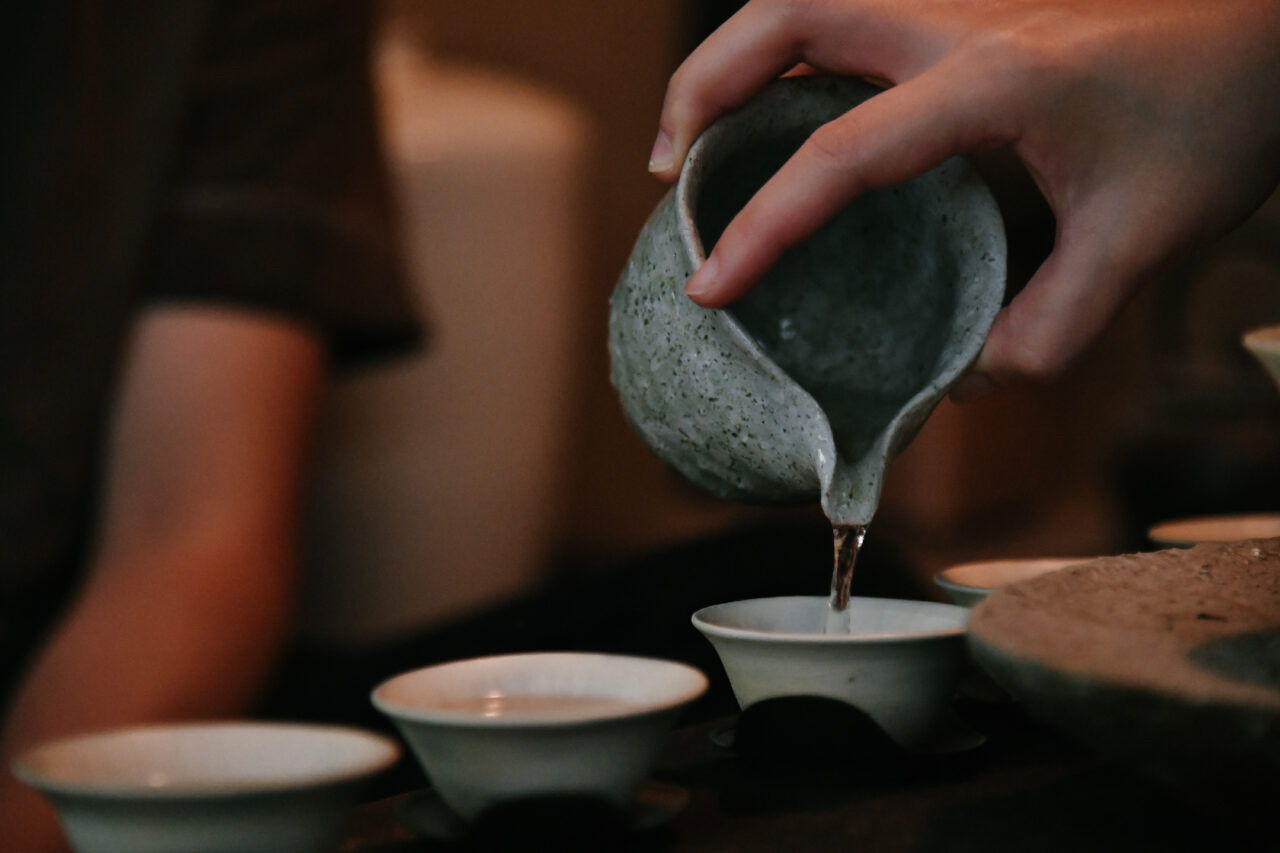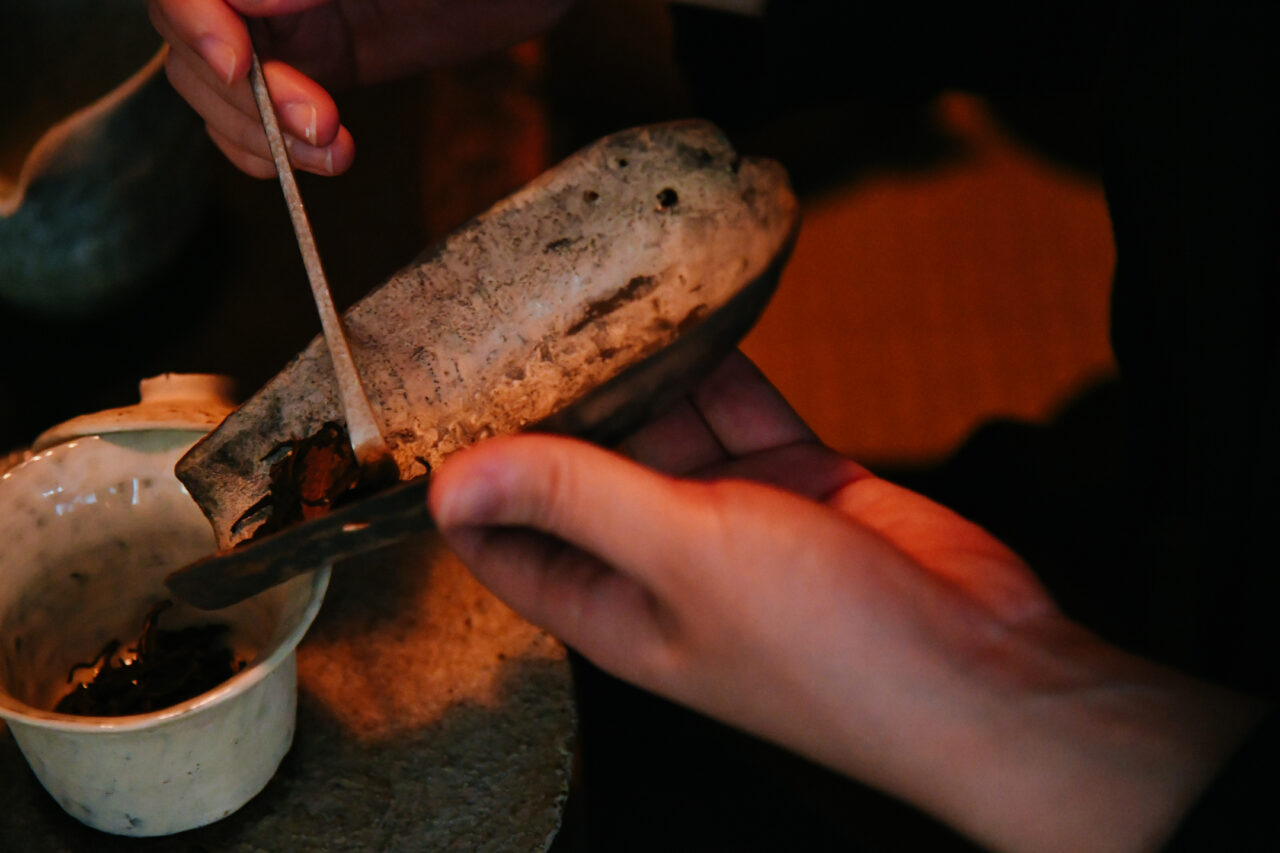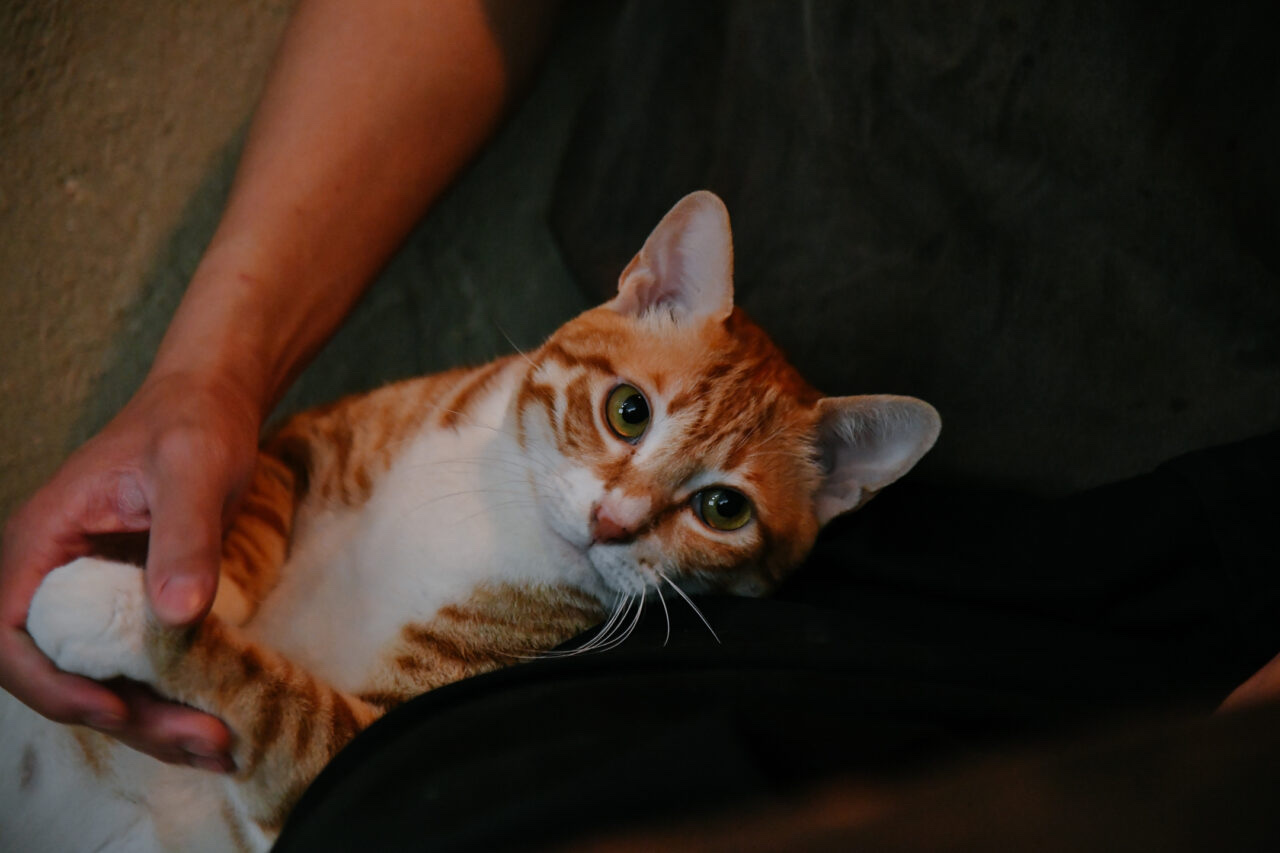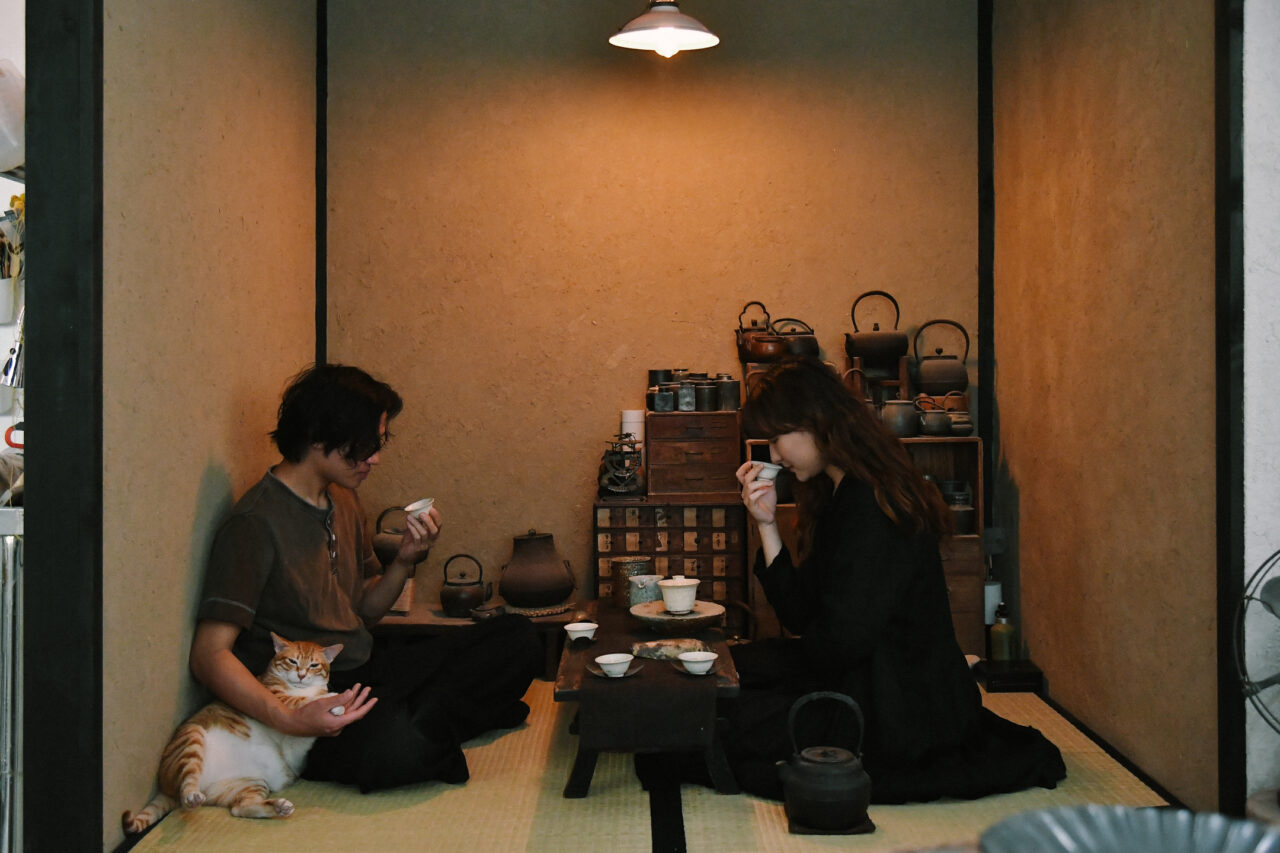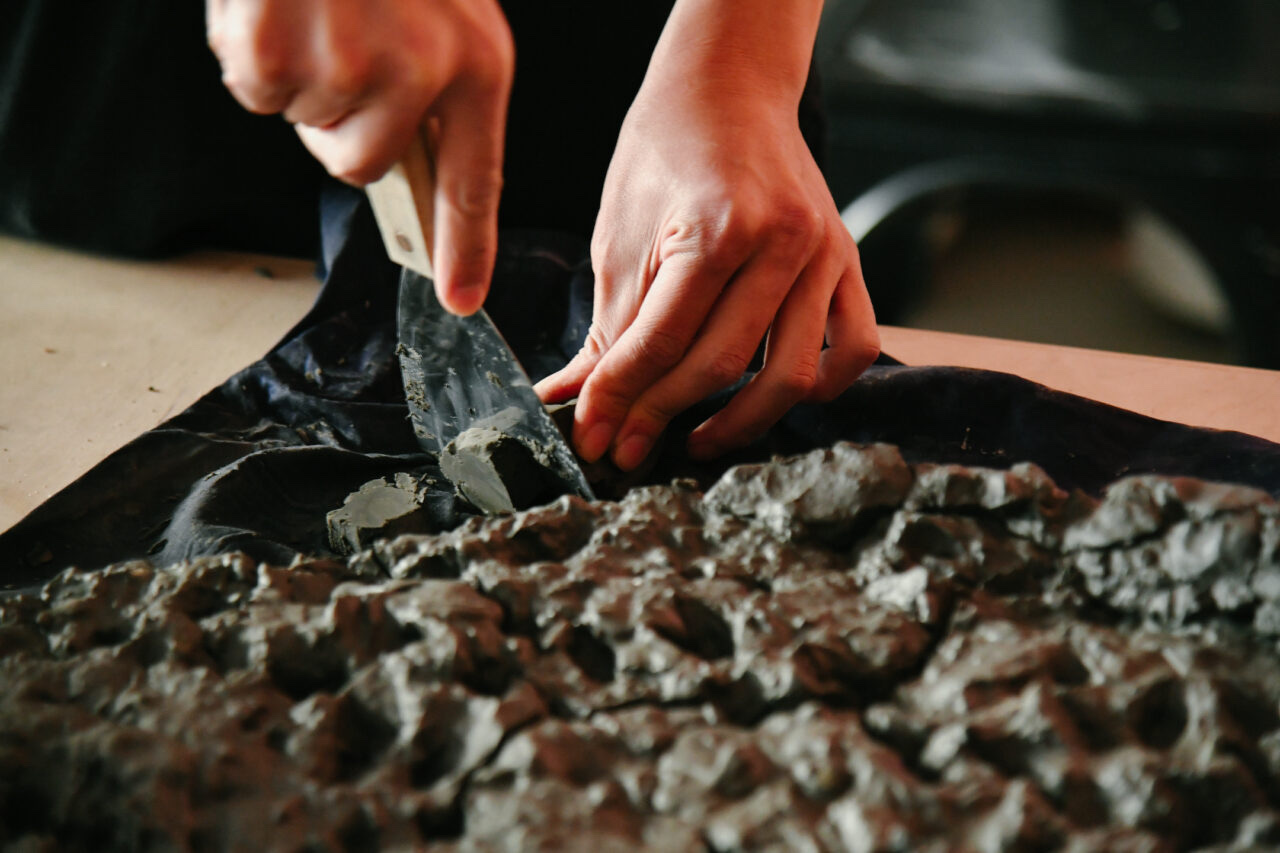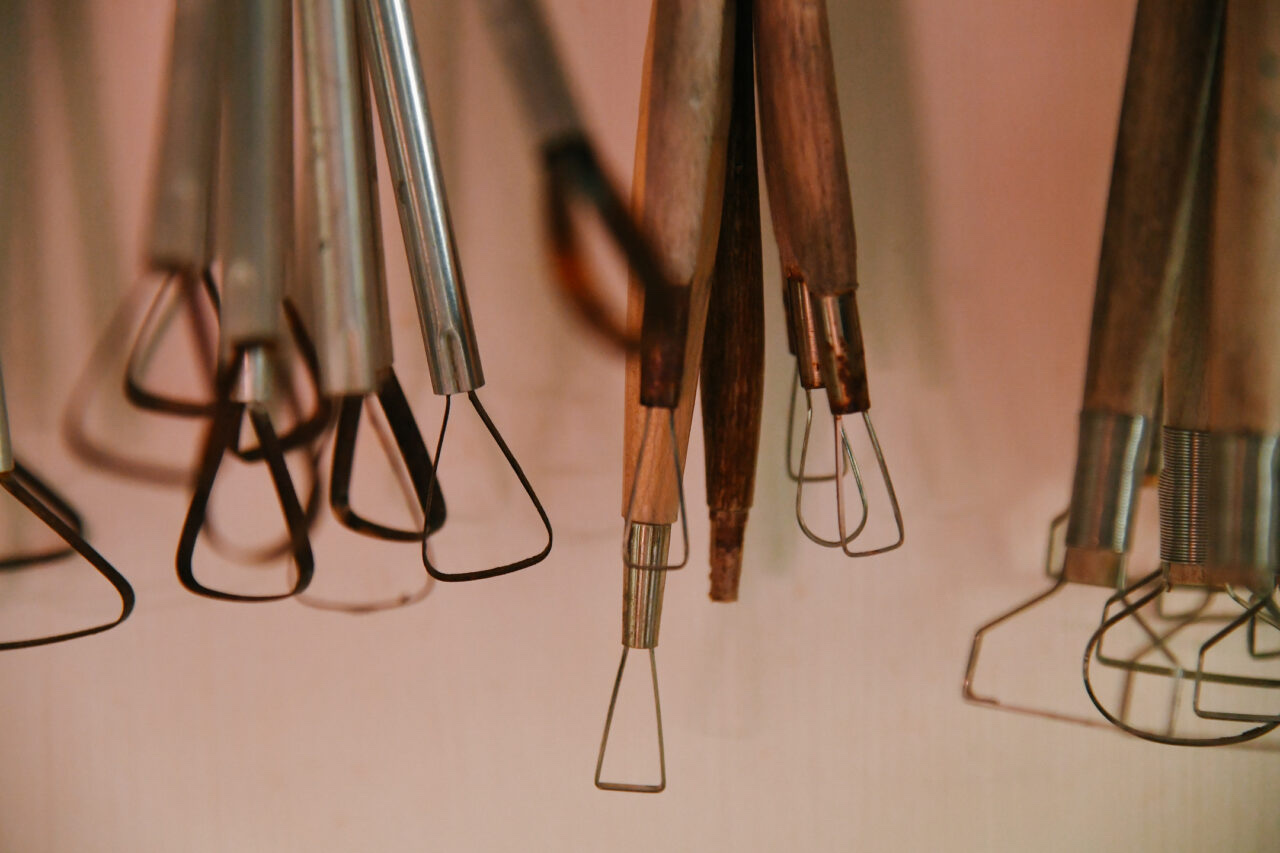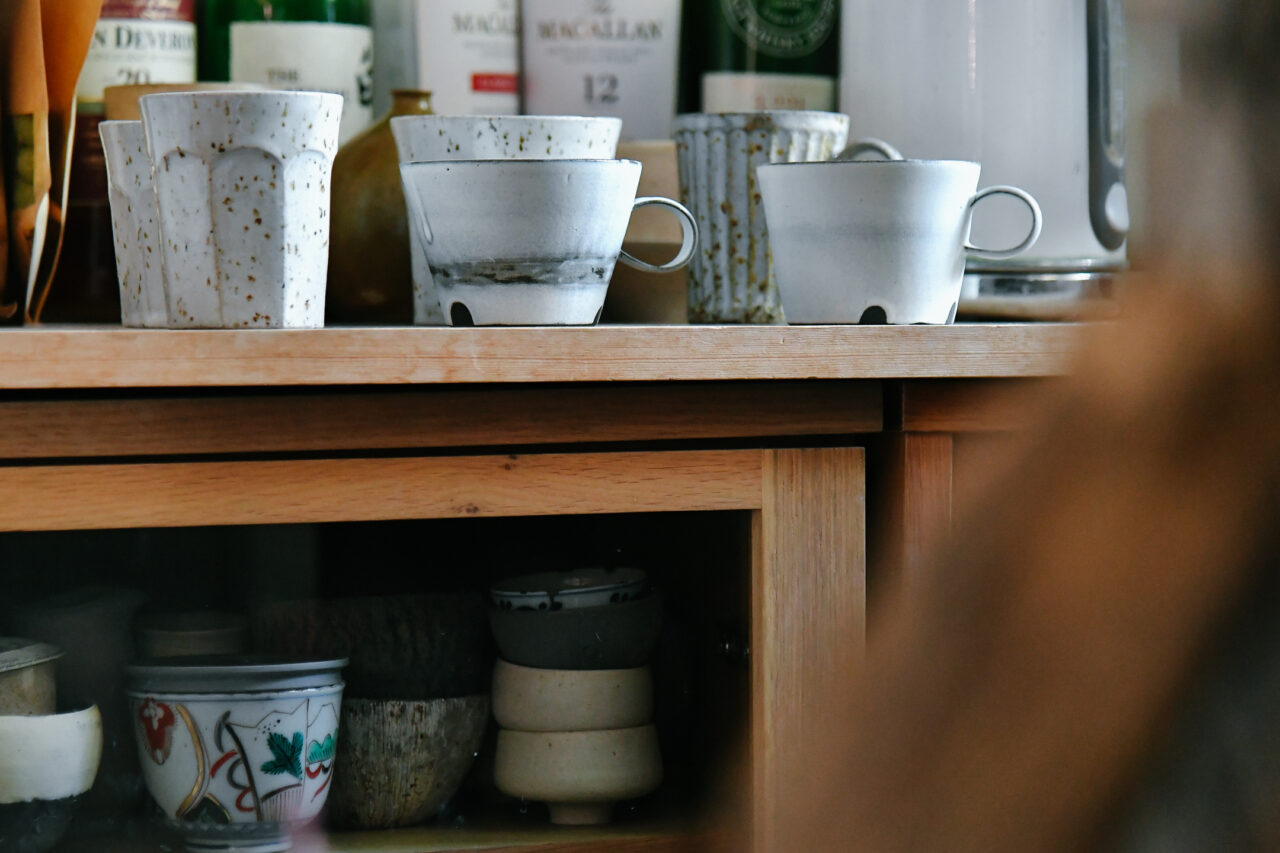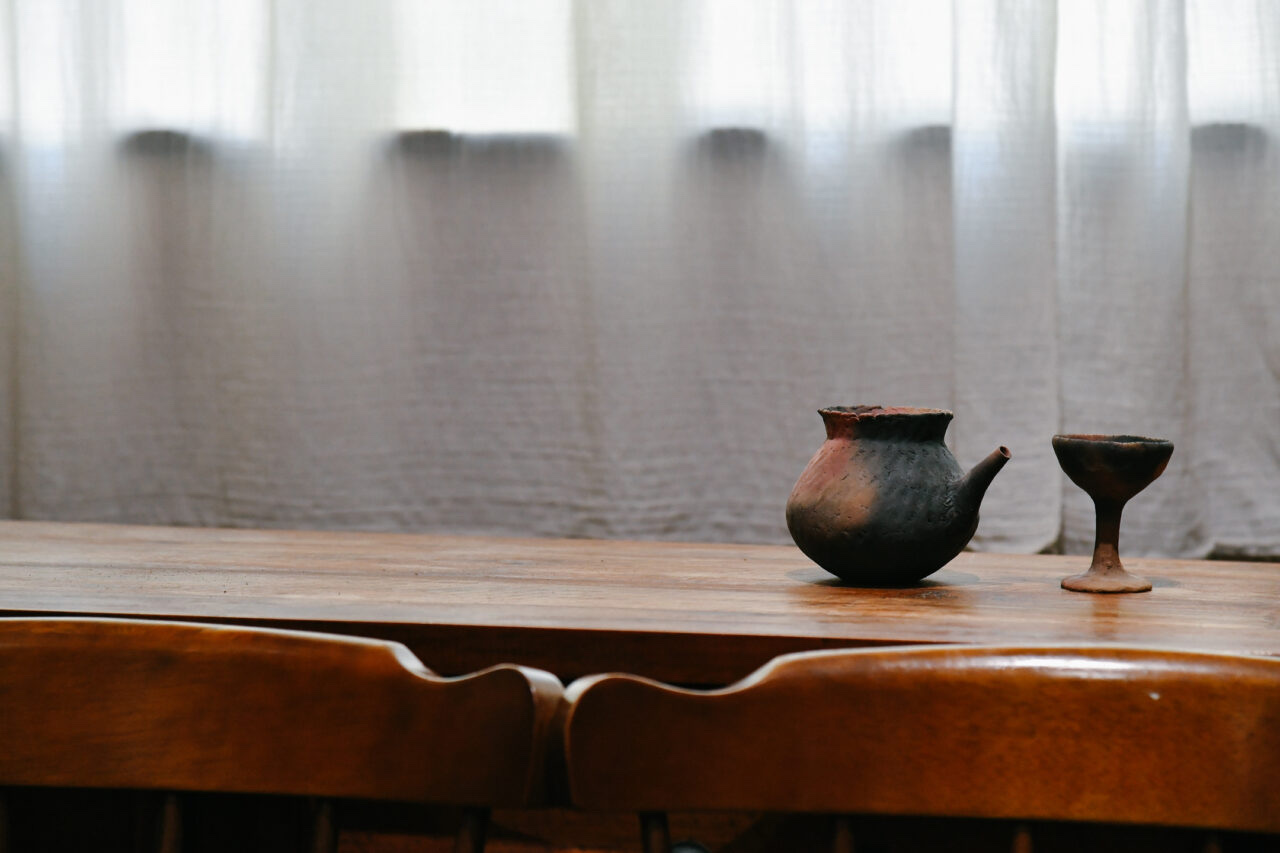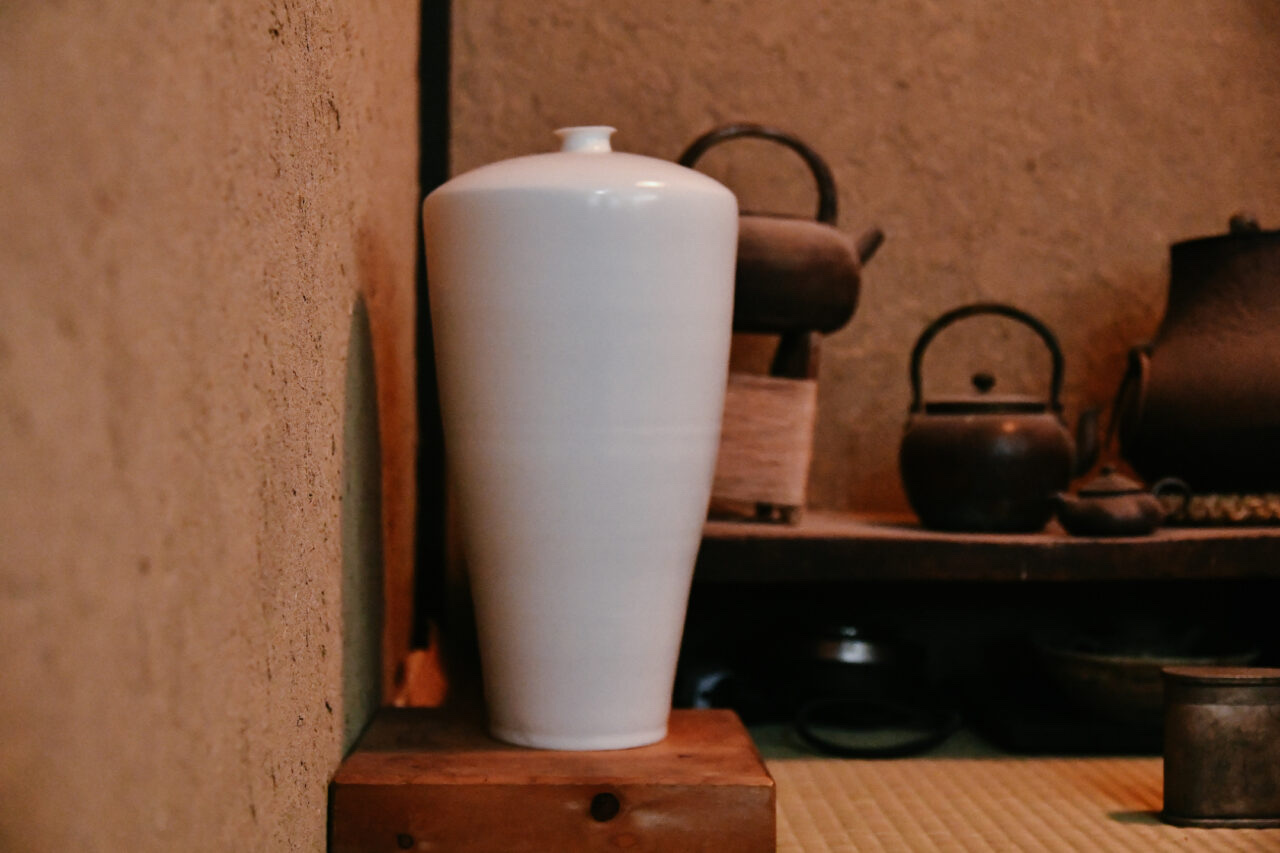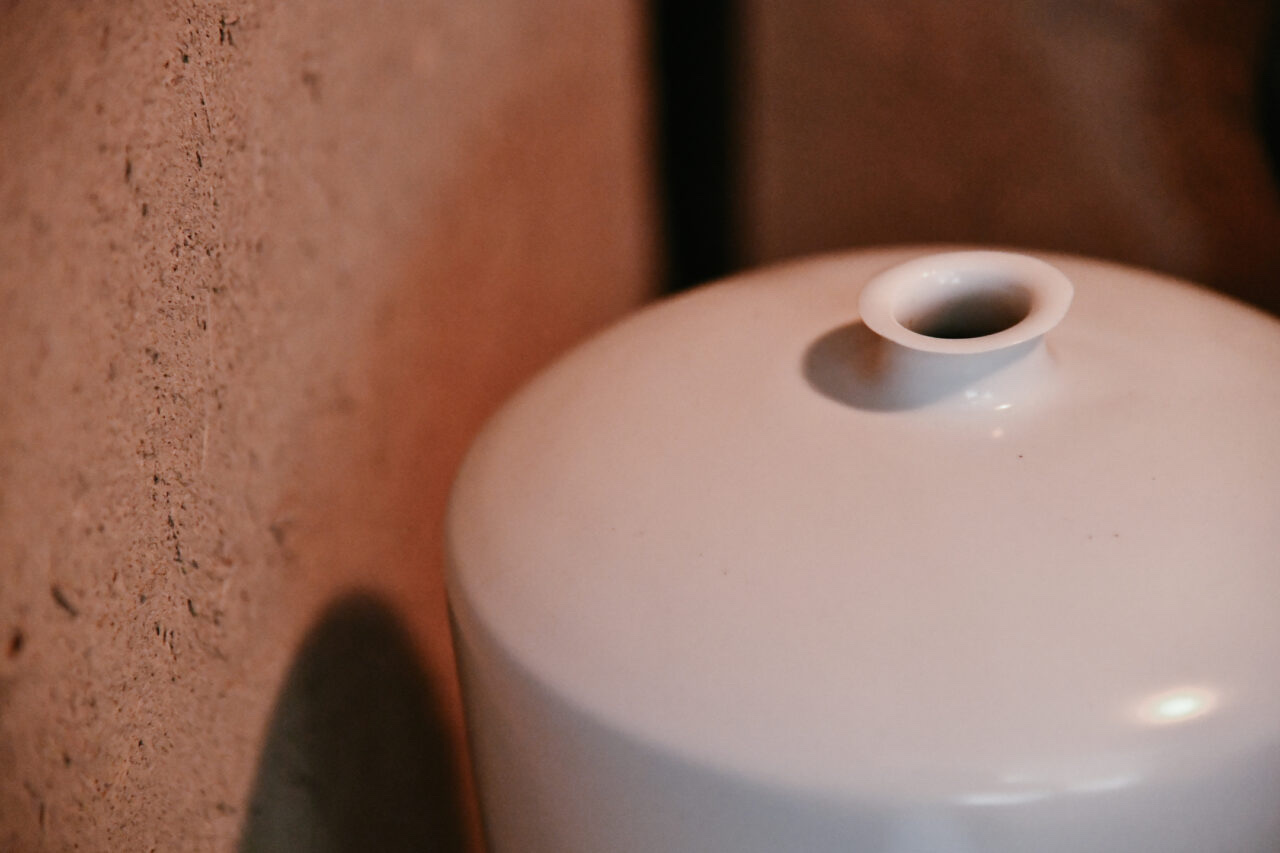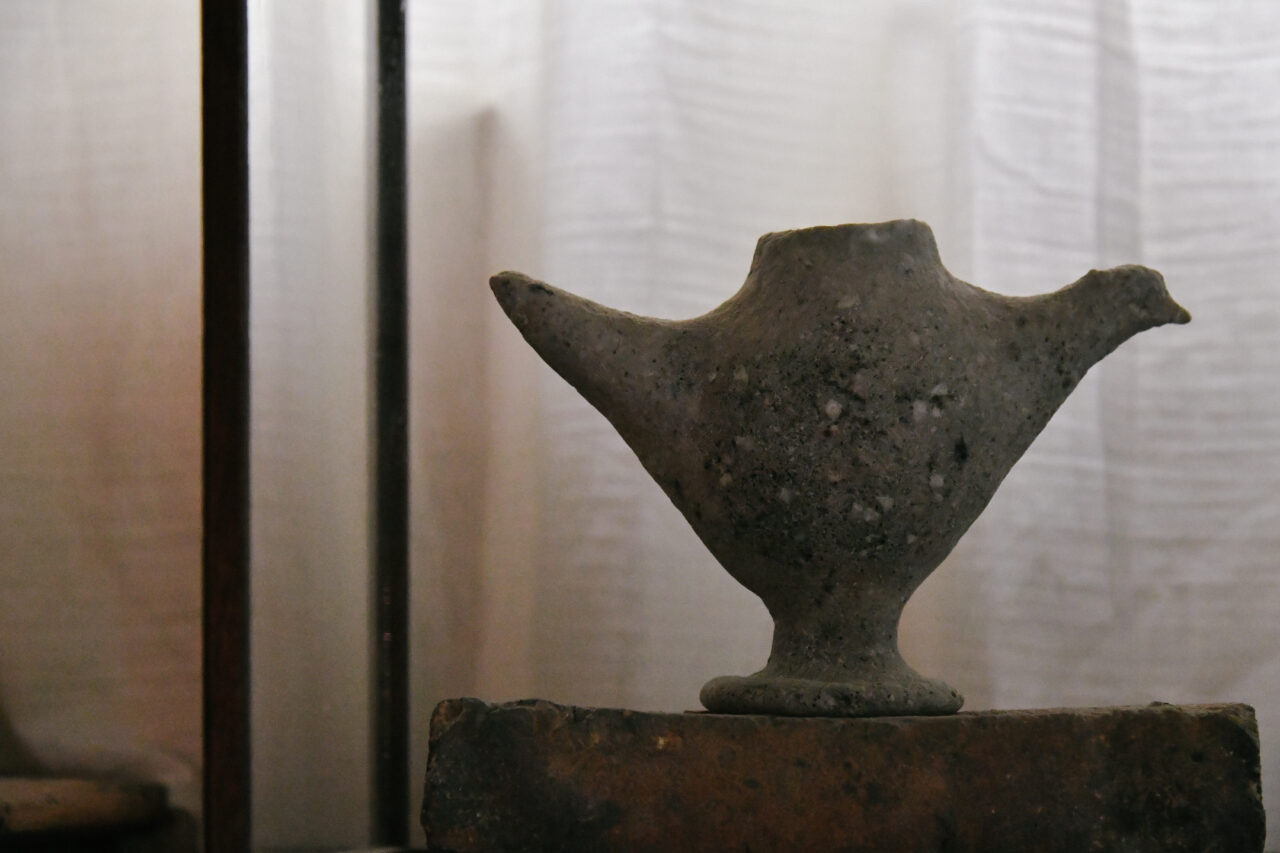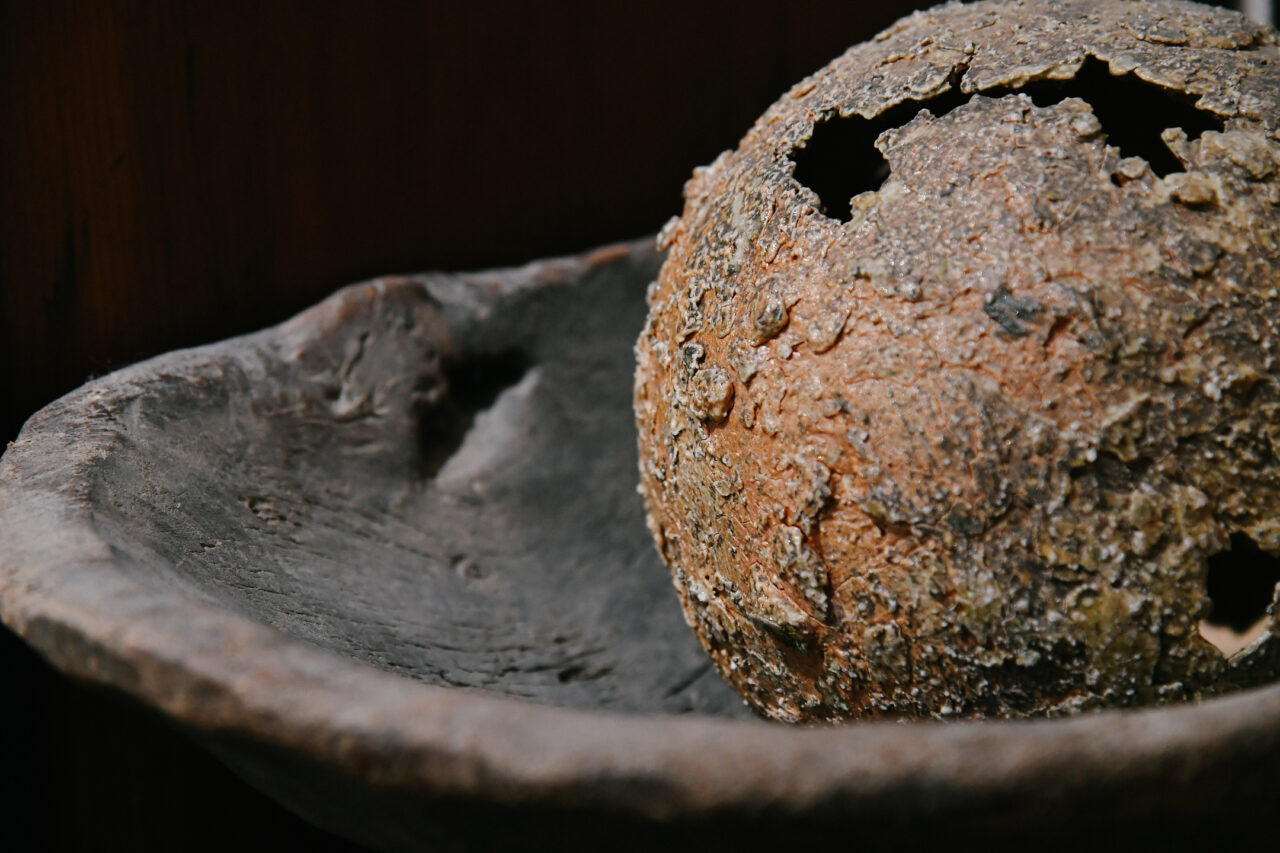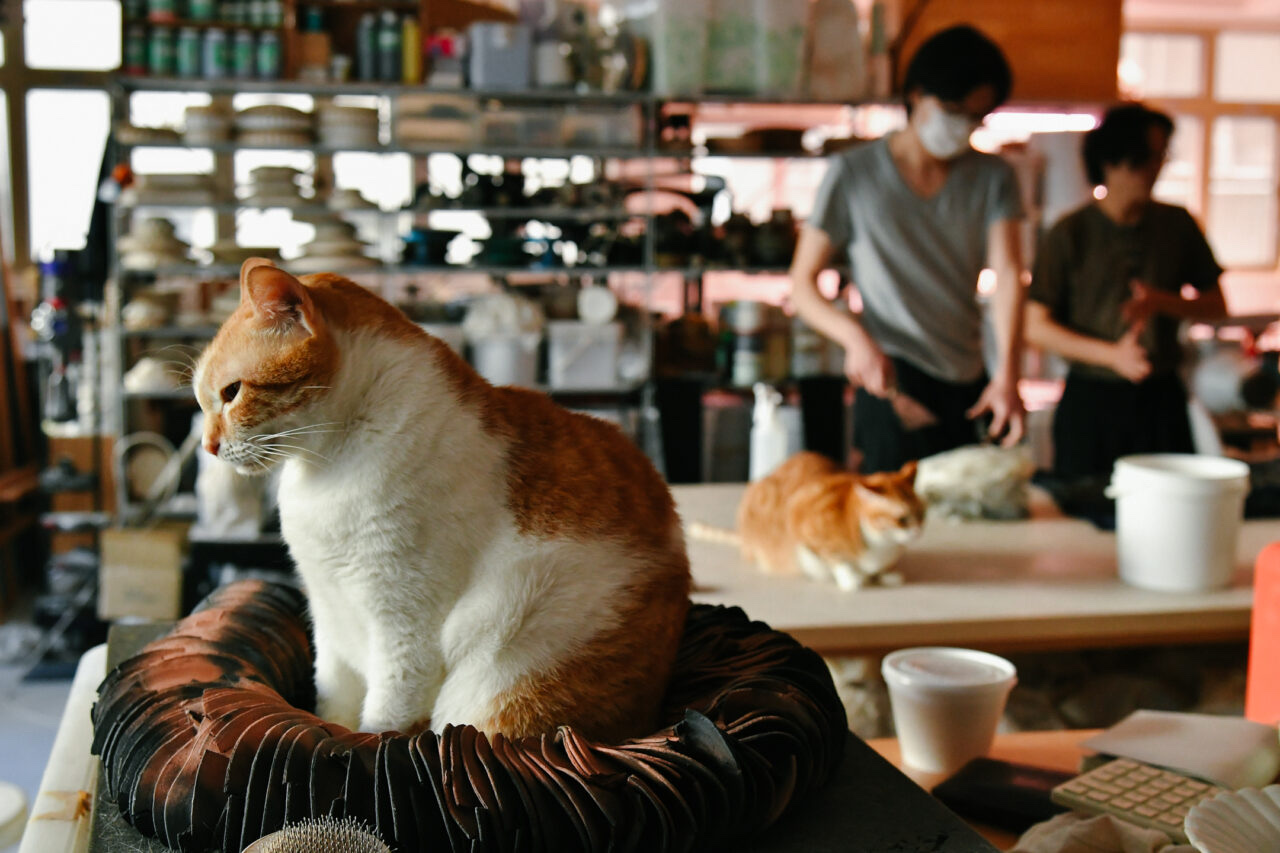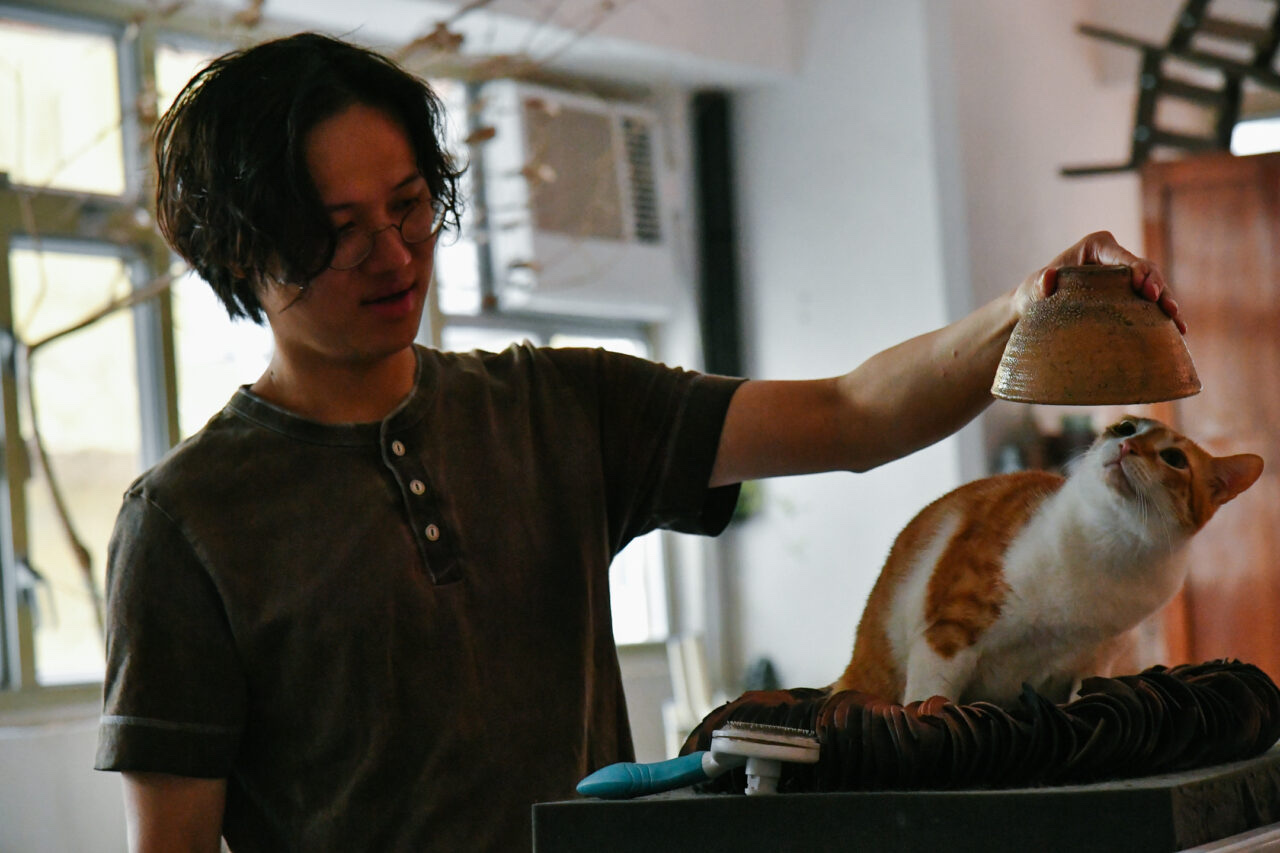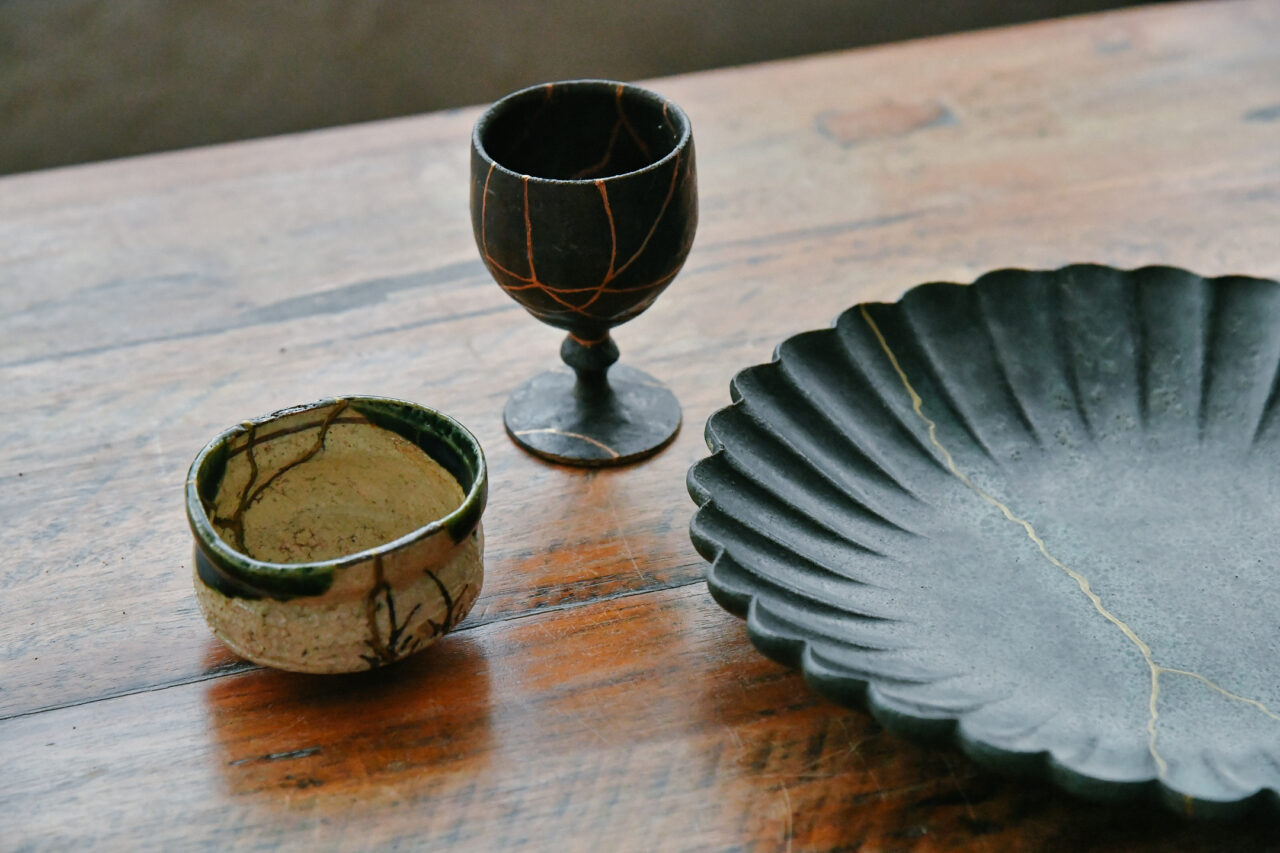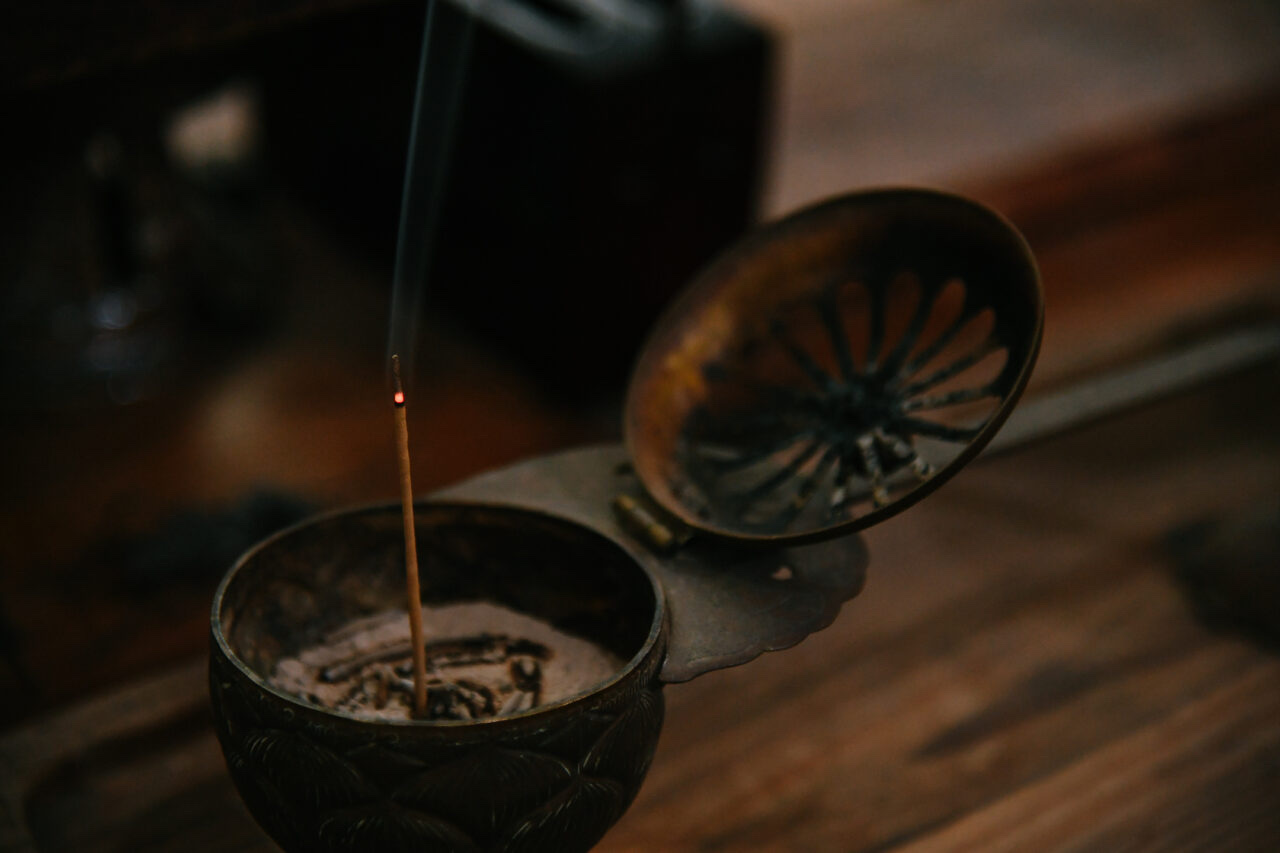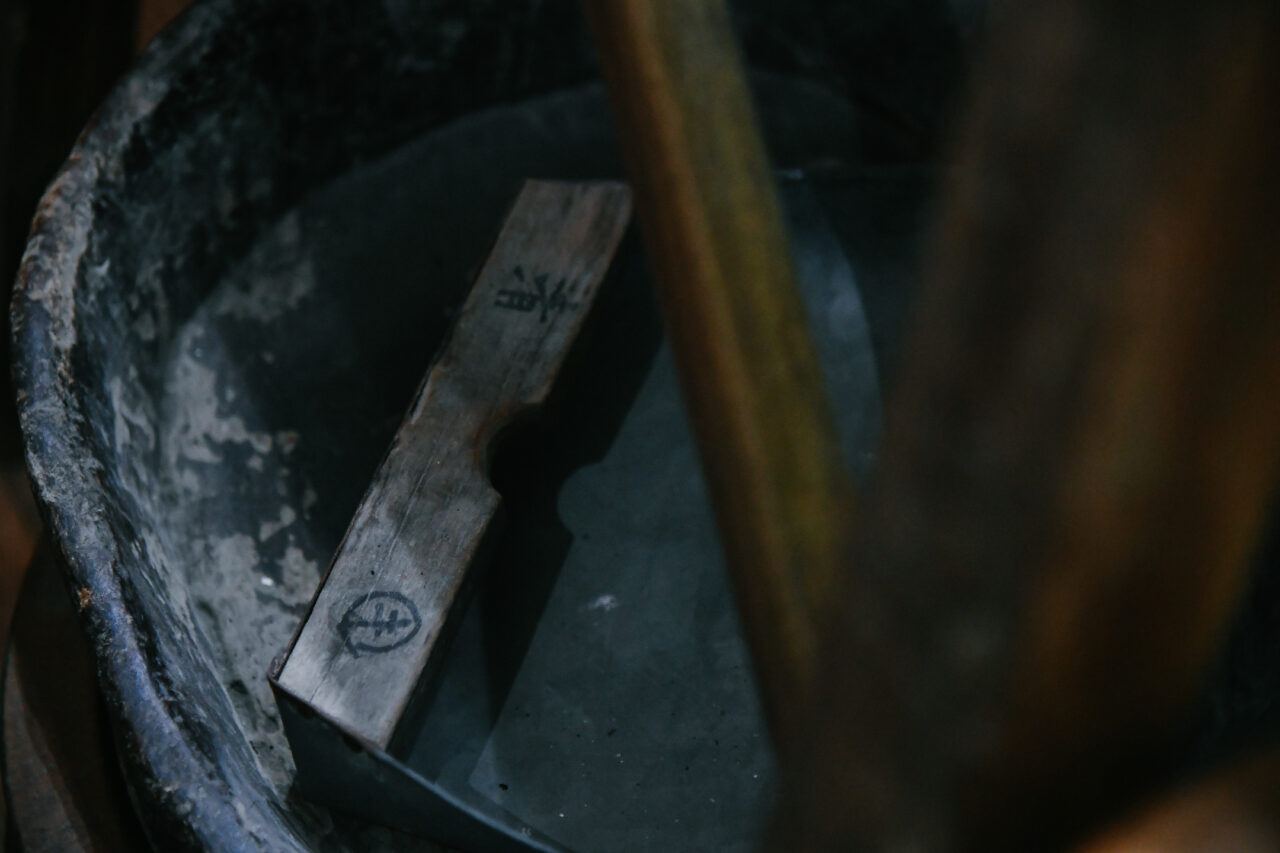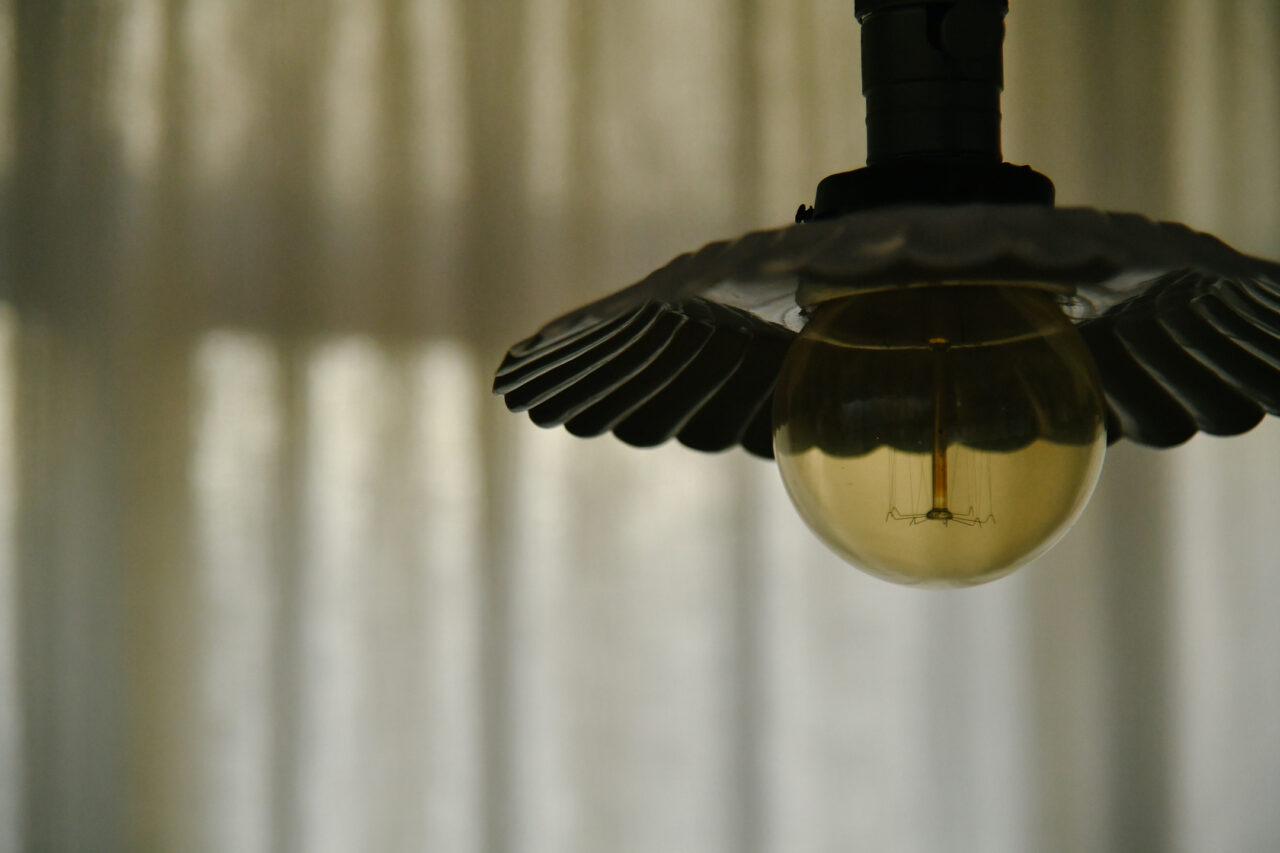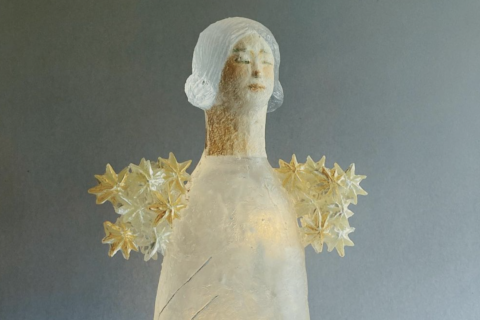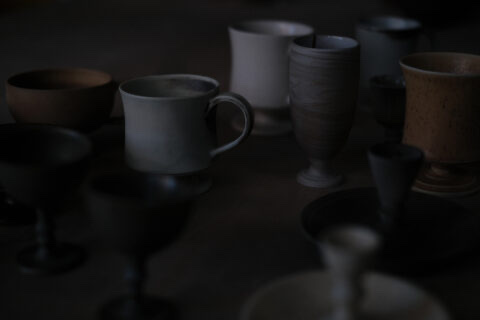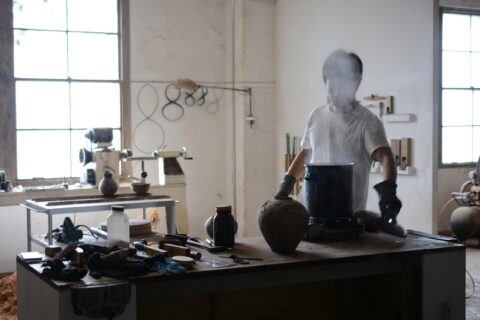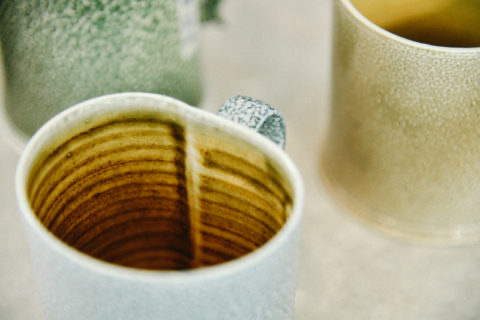走進梨木製陶所,推開沉甸甸的鐵門,通往工作室前的一個展覽空間,放著Ryan和Wy從各地搜集回來的古物,百子櫃、布料、桌子、花瓶⋯⋯,與他們製作的陶器自然而然地融合起來,沒有半點違和感。訪問完畢,喝著茶杯裡涼了的茶,落日透過窗紗灑落在工作室裡,貓兒安靜地睡在櫃子上,寧靜得只聽到電窯爐發出一陣陣的噏噏聲。
Toki Nashiki has a heavy iron door that leads to a work studio where, in front of it, is an exhibition area showcasing collectibles that Ryan and Wy have curated from around the world — a Chinese cabinet with multiple drawers, fabrics, tables, vases… These items blend well together with the pottery works created by the duo without the slightest sense of incongruity. We sat down to sip tea that was no longer hot. The setting sun shone through the sheer window curtain. The cats were sleeping peacefully on top of the cabinet. It was so quiet that the buzzing sound of the electric kiln echoed throughout the studio.
「做陶就像一道門,每次打開都遇上不同的人和風景,與這些人互相欣賞和真誠相處,是一些很深的緣份。」
2018年時,他們為當代陶瓷藝術展做了1000個碗、名為《集器》的展覽,陶碗在展覽後回到使用者手中,陪伴他們生活下去。Wy:「早兩天,恰好看到其中一位使用者為碗拍了照片,記錄使用的感受,分享到社交平台並標籤了我們。他寫到碗的編碼是852,每次使用都讓他感到這城市能創造美好,也就能堅強地撐過悲傷。這些分享、回饋讓我們十分感動,推動著我們前進,並相信自己做的事是對的。」
器物是一個了解藝術的媒介,也是最貼近生活的藝術形態。「陶器是一種物質能啟發我們思考,怎樣定義它、它是否載物,對我來說一點也不重要。人們可以使用它,而它能為人們帶來更好的生活、啟發人們更多的思考,這才是最重要的事情。」Wy一邊喝著剛泡好的茶,一邊說。「我希望我們做出來的器物能陪伴使用的人一輩子。每天都自由地使用它們,不需要小心翼翼、生怕打破它們。透過使用,陶器會產生變化,每一天都是新的相處、新的接觸,與它們一起成長,這是我們最想看見的。」
“Making pottery is like opening a door. You see something new and meet someone new every time you open that door. You wholeheartedly interact with the people you meet and genuinely respect each other. I consider that destiny.”
Ryan and Wy’s project, Remark a Bowl, was an exhibit on display in the 2018 Contemporary Ceramic Art Exhibition. For the project, the duo created 1,000 ceramic bowls which were distributed to volunteers after the exhibition. “Two days ago, I happened to see one of the volunteers share a photo of his bowl and tag us on a social media platform. The volunteer mentioned that his bowl is numbered ‘852’. It connects him with the city and reminds him that if we can create something wonderful, we can also fight through the darkness. We are very much touched and moved by this type of sharing and feedback. They push us forward and remind us that we are doing the right thing,” said Wy.
Vessels are a medium that translate art and an art form that is closest to life. “Pottery inspires us to think. It doesn’t matter how we define the vessels or whether they can actually hold something. What matters the most is that people can use them, and they can in turn make life better and inspire people to think.” Wy continued as he sipped the freshly brewed tea, “I hope the vessels we created can spend their life with their users. The users can use them freely, without having to worry that they might break them. Pottery changes over time when in use. Every day is a new start, a new connection. We’d love to see that the pottery grows together with their users.”
「做陶的世界實在太大,一輩子也做不完。」
「一開始接觸陶藝,大部分時間只專注於拉坯上,對器物不甚了解。你說你的作品是碗,別人不一定認為是。後來發現,器物在外觀的定義上是有一定的規範,使用上也有一些規定和細節要注意。」Ryan說做陶後,使他們認識到不同的人,如泡茶、沖咖啡的人,廚師或是插花的人。在他們身上了解不同領域裡的器物。「如果我們不懂泡茶的流程或如何泡茶,便不能做到一個好的茶器,所以我們去學習茶藝,認識茶的文化。」Wy續說,「我們也不單純是因為做陶而去學茶,做陶是一個契機吧,讓我們接觸到茶藝,然後喜歡上它。」學習茶道讓他們對器物有了另一種想法。「不同類型的茶對器物的使用有不同要求,陶泥的選取、器物的形態也會影響泡茶時的水流,繼而影響茶的味道。」
工作室有一個玻璃櫃子,放滿了他們「燒壞」了的作品,變型的、有裂縫的、上釉不佳的,無法賣出的都通通拿來自用。「這個大杯子是我早期的作品,是每天都用來喝水的杯子。對於杯子的尺寸,每個人的喜好也不盡相同。我也喜歡尺寸大的碗,可以把飯餸都放在一起,不用洗很多碗碟。與日本不同,這是香港的飲食文化。」香港的居住空間細小,做陶器時也要考慮到收納的問題,碗碟除了可以疊起來,用途還要多一點。「媽媽曾跟我說,平常用的蒸魚碟不夠深,載不到醬汁,市面上又找不到深一點的蒸魚碟,於是我便做一個給她。事實上碟深一點,在使用上更方便、好用,這是手做陶器才能做得到的。」
“There’s no boundary in the world of pottery. It takes more than a lifetime to explore.”
“When I first got into pottery, I almost focused solely on throwing. I didn’t know much about vessels. If you create a bowl, people might not think the same. Though I later found out that there are certain restrictions on how vessels should look and be used.” Ryan said that pottery connects him with different people, such as those who make tea and brew coffee, cooks, and florists; and from these people, he learnt a lot more about vessels in different areas of life. “If we know nothing about brewing tea, we can’t create proper tea vessels. That’s why we started to study the art and culture of tea.” Wy continued, “Pottery is not the only reason why we dive into the world of tea. I’d say pottery offered us an opportunity to learn about tea and eventually fell in love with it.” Getting into the world of tea opened up another door for them to understand more about vessels. “Different types of tea require the use of different vessels. The selection of clay and the shape of the vessels will also affect how the water flows when brewing and ultimately the taste of the tea.”
There is a glass cabinet in the studio full of imperfect pieces; though deformed, cracked, poorly glazed, and unsellable, they are now used as everyday utensils. “This large cup is from my early work and I drink water with it every day. People have different preferences regarding the size of a cup. Personally I like large bowls as I can just put everything in without having to wash a lot of other dishes. This is probably a Hong Kong thing, which is very different from Japanese culture.” The living space in Hong Kong is usually small. That’s why the duo need to think about storage when they create. The bowls and plates need to be stackable and multipurpose. “My mother once told me that the plate she often uses for steaming fish is too shallow to hold the sauce, and she has been unable to find deeper ones on the market. That’s why I eventually made one for her. In fact, deeper plates are way more handy, and with handmade pottery, we can create the ideal plate.”
「學習金繼是因為渴望器物的生命能長久一點。」
「自從做陶後,幾乎不會再買大量生產的陶器,因為工業生產的陶器造成很多廢物,如他們的質量控制很嚴謹,白色的陶器上有一點黑色,便成為次品而被掉棄。」別人眼中的瑕疵,在他們的眼中不是。Ryan:「不論是手做或是工業生產的陶器,都應抱著惜物的心態使用,那件東西便可以用很久。」因為惜物,所以他們去學習金繼,把破爛了的陶器修補回來。「自從工作室養了兩隻貓咪,便有做金繼的需要。有些很喜歡的陶器,若然掉了很可惜,於是我們便學習金繼修補破爛的陶器。金繼是漆藝的一種,透過很多工序、花上數個月時間來完成;而且如做陶般易學難精,需要不斷練習才能做得好。」
器物除了供人使用,亦承載了許多文化,尤其是手造的器物,反映了陶藝家的想法、手感,還有時間的流逝。Ryan:「我很喜歡的日本陶藝家黑田泰藏,他只做拉坯白瓷,作品都是以器物的形式表達。他做的器物邊緣都是很薄、很尖銳的,而且參差不齊,予人一種不安、脆弱的感覺。一件器物被製造出來,不一定是給人使用的。我很喜歡他作品中的純粹,單純地表現他對陶藝的感覺。他還刻意保留一些拉坯的痕跡,其他人可能會想弄圓參差不齊的邊緣,但他就是保留了那手的痕跡在裡面。器物已不只是器物,它是一種藝術。」
Ryan和Wy曾到過日本和台灣交流陶藝、辦過不同主題的展覽,也參加過大型的陶藝市集,外地熱鬧的陶藝圈氣氛讓他們心裡開始疑問:「為什麼香港沒有?」Wy笑說:「既然沒有人辦,就由我們去辦吧!」這想法促使「一本地陶」的誕生,集合本地的陶藝家,舉辦市集、工作坊、分享會和音樂會等,原定三月舉行,可惜因疫情而延期。「對陶藝圈裡的人來說是一個很難得的機會,讓創作人多點交流。我們很想把有心做陶的人都凝聚在一起,那份力量是無法估量的,希望亞洲地區的人也知道香港是有陶藝家的。」Wy說曾經到泰國交流時,看到當地的陶藝家很努力地建立自己的風格,讓世界看到泰國的陶藝,使她很感動。「這激發我們也要為香港的陶藝圈去做一些什麼。」
訪問的尾聲,我問到:「是什麼推動你們一直做陶?」二人異口同聲說:「因為鍾意。」我頓時為自己問了一個蠢問題而感到尷尬。做自己喜歡的事情,不是理所當然嗎?「熱衷於自己喜歡的東西,便不會計較付出。做陶讓我們成為一個更好的人。」
“We hope to extend the life of the vessels through kintsugi.”
“Ever since I started making it myself, I almost never buy mass-produced pottery because their production produces a lot of waste. Tight quality control means that even a tiny black dot would lead to a white pottery product being thrown into the trash.” The artist duo has a different definition of imperfection. Ryan said, “Whether it is handmade or mass-produced pottery, we should care for them so that they can last a long time.” That’s also the reason why the two of them started practicing kintsugi to fix broken pottery. “Our two cats in the studio are the reason why we need to learn kintsugi. There are pieces that we really like and it would be a pity to put them in the trash. Kintsugi can help to fix them. Kintsugi is a lacquer art that takes months to complete the many steps required. Similar to pottery, it’s something easy to learn but difficult to master. It takes a lot of practice to do well.”
Vessels hold more than just daily necessities; they carry with them the essence of culture. Handmade pottery, in particular, reflects the creator’s thoughts and skills as well as the passage of time. “Taizo Kuroda, a Japanese ceramic artist that I admire, focuses on wheel-thrown porcelain. The vessels he creates usually have very thin, sharp, and uneven edges. There is a sense of restlessness and fragility. Vessels are not necessarily created for actual, practical use. I like that there is a sense of purity in his work as it reflects his genuine feelings for pottery. There are traces of the throwing process that are left by Kuroda in his work on purpose. People might want to fix those uneven edges, but he insists on keeping them as they are. Vessels are more than just vessels; they are art.”
Ryan and Wy have been to Japan and Taiwan for exchange programmes and exhibitions. They have also participated in large-scale pottery fairs. The lively atmosphere of these events made them ponder, “Why is there nothing like that in Hong Kong?” Wy said with a smile, “Let us do it if no one else is doing it!” This is how they started the Hong Kong Local Ceramic Art Fair, a venue that brings together local ceramic artists. There will be markets, workshops, sharing sessions, and concerts, etc. The event was originally scheduled to be held in March, but unfortunately postponed due to the pandemic. “It’s a rare opportunity for local ceramic artists to get together and share their thoughts. We really want to unite all those who are interested in pottery. The power that they can create together is beyond immigation. I wish that local artists could be known to the Asian world.” Wy remarked that she was moved by the Thai artists she met on an exchange programme to Thailand. They work hard to create their own styles with a wish to bring people into the world of pottery in Thailand. “That inspired us to do something for our fellow ceramic artists in Hong Kong.”
At the end of the interview, I asked, “What motivates you to keep doing pottery?” The two of them said in unison, “Because we love it.” I felt embarrassed for asking such a foolish question. Isn’t it natural to do what you love? “If you are passionate about what you do, you don’t ask for a return. Pottery makes us better people.”
